#rotation of molecules
Explore tagged Tumblr posts
Text

TSRNOSS, p 619.
#hydrochloric acid#Faraday Cage Effect#aromatic rings#resonance stabilization#thyroid hormone#beta radiation#electron affnity of oxygen#oxidative phosphorylation#superoxide#Heisenberg's Uncertainty Principle#rotation of molecules#nitric oxide#velocity of oxygen molecules#ultraviolet absorption by the ozone layer#satyendra snkavally#manucript#calligraphy#diaries#handwriting
0 notes
Text
Paul Newman in Slap Shot (1977) “All I Can Get” Saturday
#post catered to Me#this line has been rotating in the molecule-altering microwavelike machine that is my brain for the past few weeks#this movie is audaciously stupid#and hysterical#many such instances#reggie dunlop the most heedless slimy and ebullient paul newman#unabashedly going below the belt#slap shot 1977
60 notes
·
View notes
Text
If you were to rotate one or another molecule in a clump it would noticeably disrupt the molecular patterns.
"The Fabric of the Cosmos" - Brian Greene
#book quote#the fabric of the cosmos#brian greene#nonfiction#rotation#molecule#water#disruption#pattern
2 notes
·
View notes
Text
my intuition for optical isomers hath disappeared. girl just rotate that thing
#wizardspeak#i get it in theory i KNOW u cant rotate it. but i just cant visualise larger molecules like this :-(
4 notes
·
View notes
Text
The ability of molecules to rotate a plane of polarised light can be observed with the use of a polarimeter in the following way (see figure 17.25).
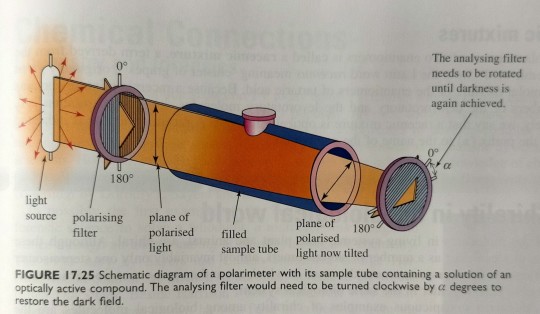
"Chemistry" 2e - Blackman, A., Bottle, S., Schmid, S., Mocerino, M., Wille, U.
#book quotes#chemistry#nonfiction#textbook#molecules#rotation#polarization#light#polarized light#schematics#light source#filter#sample#analysis
1 note
·
View note
Text
Kelly and Zach Weinersmith’s “A City On Mars”
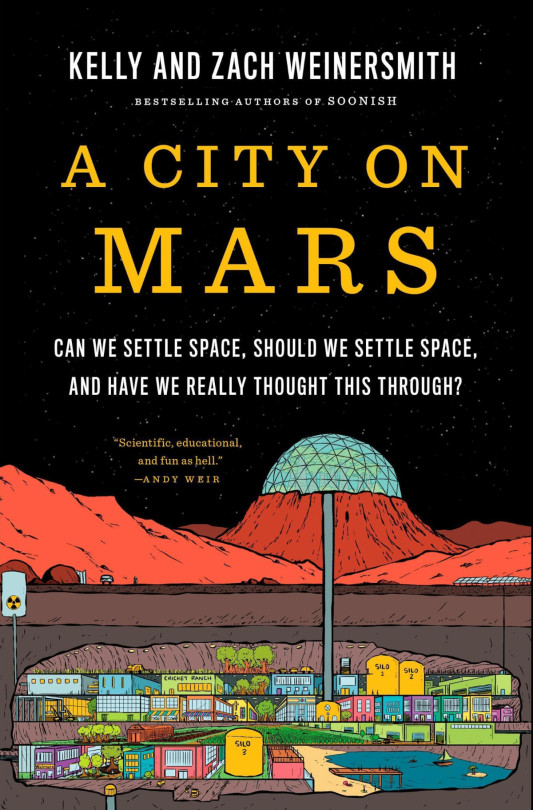
In A City On Mars, biologist Kelly Weinersmith and cartoonist Zach Weinersmith set out to investigate the governance challenges of the impending space settlements they were told were just over the horizon. Instead, they discovered that humans aren't going to be settling space for a very long time, and so they wrote a book about that instead:
https://www.acityonmars.com/
The Weinersmiths make the (convincing) case that ever aspect of space settlement is vastly beyond our current or reasonably foreseeable technical capability. What's more, every argument in favor of pursuing space settlement is errant nonsense. And finally: all the energy we are putting into space settlement actually holds back real space science, which offers numerous benefits to our species and planet (and is just darned cool).
Every place we might settle in space – giant rotating rings, the Moon, Mars – is vastly more hostile than Earth. Not just more hostile than Earth as it stands today – the most degraded, climate-wracked, nuke-blasted Earth you can imagine is a paradise of habitability compared to anything else. Mars is covered in poison and the sky disappears under planet-sized storms that go on and on. The Moon is covered in black-lung-causing, razor-sharp, electrostatically charged dust. Everything is radioactive. There's virtually no water. There are temperature swings of hundreds of degrees every couple of hours or weeks. You're completely out of range of resupply, emergency help, or, you know, air.
There's Helium 3 on the Moon, but not much of it, and there is no universe in which is it cheaper to mine for Helium 3 on the Moon than it is to mine for it on Earth. That's generally true of anything we might bring back from space, up to and including continent-sized chunks of asteroid platinum.
Going to space doesn't end war. The countries that have gone to space are among the most militarily belligerent in human history. The people who've been to space have come back perfectly prepared to wage war.
Going to space won't save us from the climate emergency. The unimaginably vast trove of material and the energy and advanced technology needed to lift it off Earth and get it to Mars is orders of magnitude more material and energy than we would need to resolve the actual climate emergency here.
We aren't anywhere near being a "multiplanetary species." The number of humans you need in a colony to establish a new population is hard to estimate, but it's very large. Larger than we can foreseeably establish on the Moon, on Mars, or on a space-station. But even if we could establish such a colony, there's little evidence that it could sustain itself – not only are we a very, very long way off from such a population being able to satisfy its material needs off-planet, but we have little reason to believe that children could gestate, be born, and grow to adulthood off-planet.
To top it all off, there's space law – the inciting subject matter for this excellent book. There's a lot of space law, and while there are some areas of ambiguity, the claims of would-be space entrepreneurs about how their plans are permissible under the settled parts of space law don't hold up. But those claims are robust compared to claims that space law will simply sublimate into its constituent molecules when exposed to the reality of space travel, space settlement, and (most importantly) space extraction.
Space law doesn't exist in a vacuum (rimshot). It is parallel to – and shares history with – laws regarding Antarctica, the ocean's surface, and the ocean's floor. These laws relate to territories that are both vastly easier to access and far more densely populated by valuable natural resources. The fact that they remain operative in the face of economic imperatives demands that space settlement advocates offer a more convincing account than "money talks, bullshit walks, space law is toast the minute we land on a $14 quadrillion platinum asteroid."
The Weinersmiths have such an account in defense of space law: namely, that space law, and its terrestrial analogs, constitute a durable means of resolving conflicts that would otherwise give rise to outcomes that are far worse for science, entrepreneurship, human thriving or nation-building than the impediments these laws represent.
What's more, space law is enforceable. Not only would any space settlement be terribly, urgently dependent on support from Earth for the long-foreseeable future, but every asteroid miner, Lunar He3 exporter and Martian potato-farmer hoping to monetize their products would have an enforcement nexus with a terrestrial nation and thus the courts of that nation.
But the Weinersmiths aren't anti-space. They aren't even anti-space-settlement. Rather, they argue that the path to space-based scientific breakthroughs, exploration of our solar system, and a deeper understanding of our moral standing in a vast universe cannot start with space settlements.
Landing people on the Moon or Mars any time soon is a stunt – a very, very expensive stunt. These boondoggles aren't just terribly risky (though they are – people who attempt space settlement are very likely to die horribly and after not very long), they come with price-tags that would pay for meaningful space science. For the price of a crewed return trip to Mars, you could put multiple robots onto every significant object in our solar system, and pilot an appreciable fleet of these robot explorers back to Earth with samples.
For the cost of a tiny, fraught, lethal Moon-base, we could create hundreds of experiments in creating efficient, long-term, closed biospheres for human life.
That's the crux of the Weinersmiths' argument: if you want to establish space settlements, you need to do a bunch of other stuff first, like figure out life-support, learn more about our celestial neighbors, and vastly improve our robotics. If you want to create stable space-settlements, you'll need to create robust governance systems – space law that you can count on, rather than space law that you plan on shoving out the airlock. If you want humans to reproduce in space – a necessary precondition for a space settlement that lasts more than a single human lifespan – then we need to do things like breed multiple generations of rodents and other animals, on space stations.
Space is amazing. Space science is amazing. Crewed scientific space missions are amazing. But space isn't amazing because it offers a "Plan B" for an Earth that is imperiled by humanity's recklessness. Space isn't amazing because it offers unparalleled material wealth, or unlimited energy, or a chance to live without laws or governance. It's not amazing because it will end war by mixing the sensawunda of the "Pale Blue Dot" with the lebensraum of an infinite universe.
A science-driven approach to space offers many dividends for our species and planet. If we can figure out how to extract resources as dispersed as Lunar He3 or asteroid ice, we'll have solved problems like extracting tons of gold from the ocean or conflict minerals from landfill sites, these being several orders of magnitude more resource-dense than space. If we can figure out how to create self-sustaining terraria for large human populations in the radiation-, heat- and cold-blasted environs of space, we will have learned vital things about our own planet's ecosystems. If we can build the robots that are necessary for supporting a space society, we will have learned how to build robots that take up the most dangerous and unpleasant tasks that human workers perform on Earth today.
In other words, it's not just that we should solve Earth's problems before attempting space settlement – it's that we can't settle space until we figure out the solutions to Earth's problems. Earth's problems are far simpler than the problems of space settlement.
As I read the Weinersmiths' critique of space settlement, I kept thinking of the pointless AI debates I keep getting dragged into. Arguments for space settlement that turn on existential risks (like humanity being wiped out by comets, sunspots, nuclear armageddon or climate collapse) sound an awful lot like the arguments about "AI safety" – the "risk" that the plausible sentence generator is on the verge of becoming conscious and turning us all into paperclips.
Both arguments are part of a sales-pitch for investment in commercial ventures that have no plausible commercial case, but whose backers are hoping to get rich anyway, and are (often) sincerely besotted with their own fantasies:
https://locusmag.com/2023/12/commentary-cory-doctorow-what-kind-of-bubble-is-ai/
Both AI and space settlement pass over the real risks, such as the climate consequences of their deployment, or the labor conditions associated with their production. After all, when you're heading off existential risk, you don't stop to worry about some carbon emissions or wage theft.
And critically, both ignore the useful (but resolutely noncommercial) ways that AI or space science can benefit our species. AI radiology analysis might be useful as an adjunct to human radiological analysis, but that is more expensive, not less. Space science might help us learn to use our materials more efficiently on Earth, and that will come long before anyone makes rendezvous with a $14 quadrillion platinum asteroid.
There are beneficial uses for LLMs. When the Human Rights Data Analysis Group uses an LLM to help the Innocence Project New Orleans extract and categorize officer information from wrongful conviction records, they are doing something valuable and important:
https://hrdag.org/tech-notes/large-language-models-IPNO.html
It's socially important work, a form of automation that is an unalloyed good, but you won't hear about it from LLM advocates. No one is gonna get rich on improving the efficiency of overturning wrongful convictions with natural language processing. You can't inflate a stock bubble with the Innocence Project.
By the same token, learning about improving gestational health by breeding multigenerational mouse families in geosynchronous orbit is no way to get a billionaire tech baron to commit $250 billion to space science. But that's not an argument against emphasizing real science that really benefits our whole species. It's an argument for taking away capital allocation authority from tech billionaires.
I'm a science fiction writer. I love stories about space. But I can distinguish fantasy from reality and thought experiments from suggestions. Kim Stanley Robinson's 2015 novel Aurora – about failed space settlement – is every bit as fascinating and inspirational as "golden age" sf:
https://memex.craphound.com/2015/11/02/kim-stanley-robinsons-aurora-space-is-bigger-than-you-think/
But still, it inspired howls of outrage from would-be space colonists. So much so that Stan wrote a brilliant essay explaining what we were all missing about space settlement, which I published:
https://boingboing.net/2015/11/16/our-generation-ships-will-sink.html
With City on Mars, the Weinersmiths aren't making the case for giving up on space, nor are they trying to strip space of its romance and excitement. They're trying to get us to focus on the beneficial, exciting, serious space science we can do right now, not just because it's attainable and useful – but because it is a necessary precondition for any actual space settlement in the distant future.

If you'd like an essay-formatted version of this post to read or share, here's a link to it on pluralistic.net, my surveillance-free, ad-free, tracker-free blog:
https://pluralistic.net/2024/01/09/astrobezzle/#send-robots-instead
#pluralistic#books#reviews#space#bezzles#mars#spacex#robots#science#space science#space travel#space settlement#space colonization
1K notes
·
View notes
Text
Organic Chemistry be like "this is a compound that is absolutely vital for life to exist. If you do not consume copious amounts of this substance you will die."
*rotates image 90 degrees*
"Meanwhile, this substance is the most deadly thing on the planet. If you consume even a single molecule of this, you will die a horrible death like no human has before."
74 notes
·
View notes
Text
I'm co-hosting a game jam!
What is Dice Exploder? Each week, Sam Dunnewold and a rotating cohost break down one tabletop RPG mechanic as deep as they possibly can.
For the duration of the third season, we're running a game jam inspired by the podcast's premise. You can join the DE Discord , where there's a channel for this game jam, to discuss your submission with other participants and fans of the show.
Explode a game you love (or want to love) and remix, remake, or reinterpret it in part or whole.
Dice Exploder is about zooming in on a part of a game and making it everything. This jam is about taking your favorite part of a game and dragging it to the center of the experience. Want to turn that 400 page tome you can never get anyone to play into a single-page game? Go for it! Is there a combat sim game you're pretty sure is actually about running a coffee shop? Write those rules. Taking a setting apart down to the molecules and rewriting it as barely an echo of the original? Totally fair play.
The jam runs from Feb 1 to Apr 1.
161 notes
·
View notes
Text

HUMANS NEED FANTASY TO BE HUMAN, said Death. TO BE THE PLACE WHERE THE FALLING ANGEL MEETS THE RISING APE.
"Tooth fairies? Hogfathers? Little fair--"
YES. AS PRACTICE. YOU HAVE TO START OUT LEARNING TO BELIEVE THE LITTLE LIES.
"So we can believe the big ones?"
YES. JUSTICE. MERCY. DUTY. THAT SORT OF THING. TAKE THE UNIVERSE AND GRIND IT DOWN TO THE FINEST POWDER AND SIEVE IT THROUGH THE FINEST SIEVE AND THEN SHOW ME ONE ATOM OF JUSTICE, ONE MOLECULE OF MERCY. AND YET --Death waved a hand-- AND YET YOU ACT AS IF THERE IS SOME IDEAL ORDER IN THE WORLD, AS IF THERE IS SOME… SOME RIGHTNESS IN THE UNIVERSE BY WHICH IT MAY BE JUDGED.
"Yes," returned Susan, "but people have got to believe that, or what’s the point--"
MY POINT EXACTLY. YOU NEED TO BELIEVE IN THINGS THAT AREN’T TRUE. HOW ELSE CAN THEY BECOME?
======
Happy Hogswatch my beloveds. I truly have no idea what kind of future lies ahead for us. Whether the sun is going to rise in the sky… or a flaming sphere of hydrogen and helium is going to sequentially illuminate the surface of a rotating planet. And I'm definitely not the believing sort, which I guess kind of limits my vision as an artist or as a teacher. So in the absence of anything else I'll just keep doing the few practical things that I know I can do well (or at least competently), and trust to hope that my efforts might put at least a few tablespoons' worth of good into the world --or at the very least stave off some of the really bad stuff. If that counts as belief, then I guess that's probably worth a few more sunrises.
Look after one another my dears.
37 notes
·
View notes
Text
By popular (???) request, based on the outcome of this poll.
A WARNING: you guys really did pick the most complex one. This is loooooong. A DISCLAIMER. This is a silly little lesson aimed at folks who know sod-all about MRI. There are memes. There is (arguably) overuse of the term ‘big chungus’. If you are looking to delve deeper into the mysteries of K-Space, this is not the Tumblr post for you.
So, without further ado...
Today I am introducing you to my one true love. The legend. The icon.
Ferromagnetic material loves him. Claustrophobic people fear him.
Yeah, that’s right – we’re talking about the big boom-boom sexyboy magnet machine, hereby known as Big Chungus.

Aka...
MAGNETIC RESONANCE IMAGING
First off, though? Let’s start small.
Very, very small.
Meet HYDROGEN.

The nucleus of this element is made up of a single proton, which has a magnetic dipole – i.e., it acts like a tiny bar magnet.
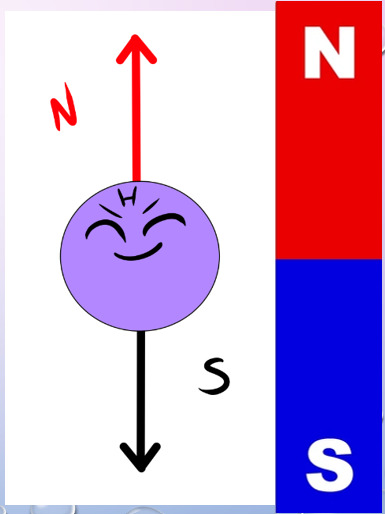
Hydrogen is also a component of water. As we all know, we’re basically walking sacks of goop – meaning that Hydrogen is abundant throughout our bodies.
Therefore, when we stick you in a strong magnetic field… say, within our friend Big Chungus… we can manipulate all those tiny Hydrogen atoms in a variety of fun ways.

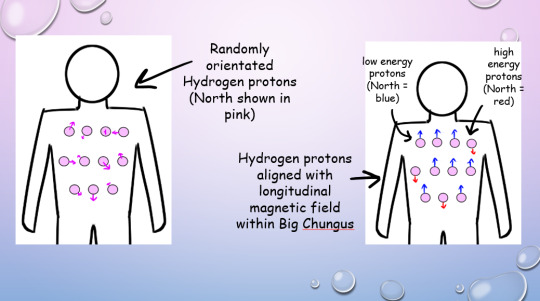
Under normal conditions, all your Hydrogen protons are pointing every-which-way.
But in Big Chungus, there is a strong longitudinal magnetic field that travels along the Z-axis of the machine. So, all your teeny tiny Hydrogen protons swivel to align with that field!
If a proton’s energy is LOWER than that of the longitudinal magnetic field (a majority), they will align PARALLEL with the field. If their energy is HIGHER (a minority) they will align ANTI-PARALLEL.
As most of the protons align with the longitudinal magnetic field, the net magnetisation vector within the human body is also longitudinal! This is called the thermodynamic equilibrium – the resting state for all those li’l protons when your body is within Big Chungus.
(You won’t feel any different, btw! We’re flipping a bunch of teeny-tiny bits inside you, but you won’t feel a thing!) (You might do later, when we activate the Gradient coils. We’ll….. get to that)
But, while all of this is very cool, it gives us no actual information. We gotta play some more with your protons - which brings us to arguably the most important concept in MRI. I mean, it’s literally in the name!

Let’s go back to our Hydrogen protons.

We’ve established that they’re all pointing in different directions. But they’re not just sitting still. They’re spinning and wobbling all over the shop.
We call this rotational wobbly movement precession.
In their natural state, these protons all precess at different speeds. When we subject them to Big Chungus, as well as all lining up neatly with the magnetic field, they all start to precess at the same speed.
However, their magnetic North will be pointing to different points at any given moment. Imagine two clocks, both of which are ticking at the same rate, but which have been set to read different times.
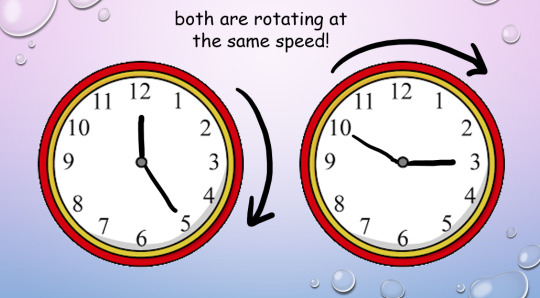
This is where magnetic resonance comes in.
In addition to the homogenous longitudinal magnetic field provided by Big Chungus, we also create an oscillating magnetic field in the transverse plane by using a radiofrequency (RF) pulse. We can tune that oscillation to the ‘resonant frequency’ of Hydrogen atoms.
Every molecule capable of resonance has its own specific frequency. We use a funky equation called the Larmor Equation to work this out, or, as I like to call it, W, BOY!!!
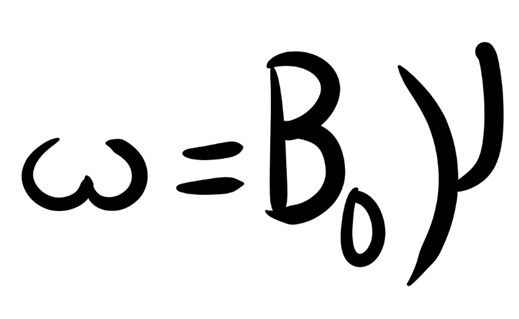
(The weird ‘w’ is the resonance frequency; the weird ‘Bo’ is the magnetic field strength, and the weird ‘Y’ is the gyromagnetic ratio of each particular element.)
So, we know exactly at what frequency to apply that RF pulse to your protons, to achieve resonance!
But what is resonance?

In acoustics, a ‘resonant frequency’ is the frequency an external wave needs to be applied at in order to create the maximum amplitude of vibrations within the object. Like when opera singers shatter glass with their voice! They’re singing at the resonant frequency of the glass, which makes it vibrate to the point where it compromises its structural integrity.
A similar concept applies in magnetic precession, with, uh, less destructive results. We’re not exploding anything inside of you, don’t worry!
(We do explode your innards accidentally in Ultrasound sometimes, via a different mechanism. But you’ll have to ask me more about that later. >:3)
To put it simply, magnetic resonance is the final step in getting those protons to BEHAVE. Now, the clocks have been corrected so their hands move at exactly the same time, in the same position. The protons are precessing ‘in phase’. Yay!
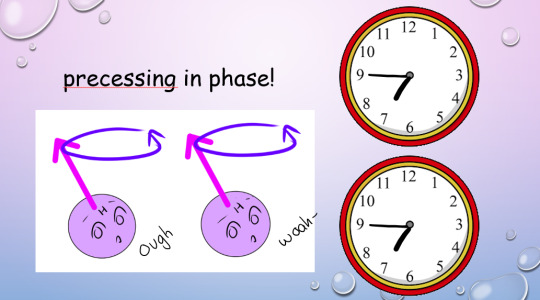
This creates transverse magnetisation, as the magnetic vectors of all those protons (which, remember, act as bar magnets) will swing around to point in one direction at the same time.
But the cool thing about resonance? It also allows the protons to absorb energy from the RF pulse.
(Do NOT ask me how. Do NOT. I will cry.)
And remember how the higher-energy protons flip anti-parallel to the longitudinal magnetic vector of Big Chungus, while the lower-energy protons are aligned parallel? And because we have more low-energy protons than high-energy protons, our body gains a longitudinal magnetic vector to match Big Chungus?
Zapping those protons at their resonant frequency gives 'em energy (a process known as ‘excitation’, which I love, because I get to imagine them putting little party hats on and having a rave).
So, loads of them flip anti-parallel! Enough to cancel out the net longitudinal magnetic vector of our bodies ��� despite the best efforts of good ol’ Chungus!
(Keep trying, Chungus. We love you.)

Our protons are as far from our happy equilibrium as they can possibly be. We’ve lost longitudinal magnetisation, and gained transverse magnetisation. Oh noooo however can we fix this ohhhh noooooo
Simple. We turn off the RF pulse.
Everything returns to that sweet, sweet thermodynamic equilibrium.
Longitudinal magnetisation is regained. I.e., the protons realign with Big Chungus’s longitudinal magnetic field, with the majority aligned parallel rather than anti-parallel.
This is called SPIN-LATTICE RELAXATION.
‘T1 time’ is the point by which 63% of longitudinal magnetisation has been regained after application of the RF pulse. A T1-weighted image shows the difference between T1 relaxation times of different tissues.
And, without that oscillating RF pulse, we lose resonance – the protons fall out of phase randomly, due to the delightful unpredictable nature of entropy, and Transverse magnetisation reduces.
This is called SPIN-SPIN RELAXATION.
Or, if we’re feeling dramatic…

‘T2 time’ is the point by which 37% of the transverse magnetisation has been lost. A T2-weighted image shows the difference between T2 relaxation times of different tissues.
(Spin-spin is objectively a hilarious phrase to say in full seriousness when surrounded by important physics-y people. However, a word to the wise: do not make a moon-moon joke. They are not on Tumblr (present company excluded). They will not understand. You will get strange looks.)

But remember how resonance lets our protons shlorp up that sweet, sweet energy from the RF pulse? Well, in order to get back to thermodynamic equilibrium and line up with Big Chungus again, they have to splort that energy back out.
This is why we stick a cage over the body part we’re imaging. That cage isn’t a magnet, or a way of keeping you still – it’s a receiver coil.
It picks up the RF signal that’s given off by your innards as they relax from the intense work-out we just put them through. How cool is that??

The amount of time we wait between applying the RF pulse and measuring the ‘echo’ from within your body is called the ‘ECHO TIME’, or ‘TE’ (because we didn’t want to call it ET).
(yes, we’re cowards. Sorry.)
We also have ‘REPETITION TIME’ or ‘TR’ – the amount of time we leave between RF pulses! This determines how much longitudinal magnetisation can recover between each pulse.

By manipulating TE and TR, we can alter the contrast (i.e., the blacks and whites) on our image.
Areas of high received signal (hyperintense) are shown as white, while areas of low received signal (hypointense) are shown as black. Different sorts of tissue will have different ratios of Hydrogen-to-other-shit, and different densities of Hydrogen-and-other-shit – ergo, some tissue blasts out all of its stored energy SUPER QUICK. Others give it off slower.
A T1-weighted image has a short TR and TE time.
Fat realigns its longitudinal magnetisation with Big Chungus SUPER QUICK. This means, on a T1-weighted image, it looks hyperintense. However, water realigns its longitudinal magnetisation with Big Chungus slooooowly. Therefore, on a T1-weighted image, fluid looks hypointense! Ya see?
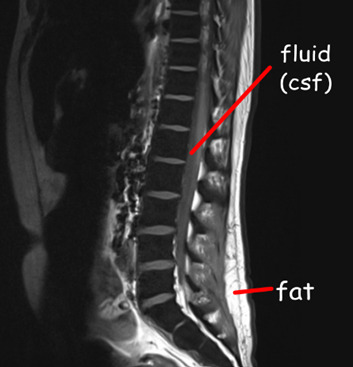
A T2-weighted image has a long TR and TE time.
The precession of protons in fat decays relatively slow, so it will look quite bright on a T2-scan. But water decays slower, and therefore, by the time we take the T2 image, fluids within the body will be giving off comparatively ‘more’ signal than fat – meaning they’ll appear more hyperintense!
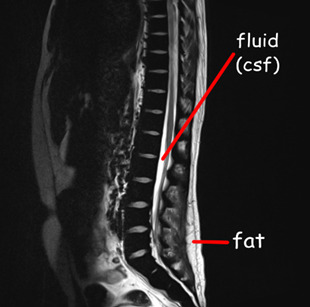
If we have a substance with intrinsically long T1 and T2 values, it will appear dark on a T1-weighted image and bright on a T2-weighted image, and the same in reverse. If a substance has a short T1 value and a long T2 value, it will appear relatively ‘bright’ on both T1 and T2-weighted images – i.e., fat and intervertebral discs.
As every tissue has its own distinct T1 and T2 property… we can work out precisely what sort of tissue we’re looking at.
When we build in all our additional sequences, this becomes even clearer! This is why your MRI scan takes sooooo long – we’re running SO MANY sequences, manipulating TR and TE to determine the exact T1 and T2 properties of various tissues within your bod.


There is, however, a problem.
The RF signal given off by each proton doesn’t shoot out in a handy-dandy straight line. Meaning, we have no idea where the signal is coming from within your body.
Enter our lord and saviour:
THE GRADIENT COILS.
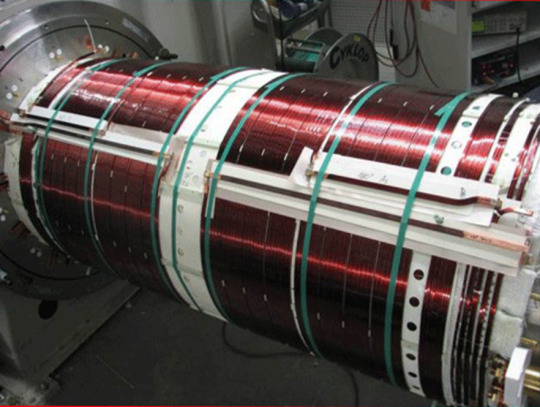
(Shim coils are also very important – they maintain field homogeneity across the whole of Big Chungus. While Big Chungus wouldn’t need them in a perfect theoretical scenario… reality ain’t that. Big Chungus’s magnetic field is all wibbly-wobbly, so we use Shims to keep everything smooth! That’s all you need to know about them. BACK TO THE GRADIENTS.)
There are three of them, wrapping around each of the three planes of your body. When these activate, they cause those epicly eerie booming noises, characteristic of a Big Chungus ExperienceTM.
youtube
The Gradient coils are also what causes those weird tingling sensations you get in an MRI machine – which, don’t worry, aren’t permanent! Your nerves just go ‘WOAHG. THASSALOT OF MAGNET SHIT. HM. DON’T LIKE THAT.’ But they’ll calm down again once you’re freed from Big Chungus.
The gradient coils cause constant fluctuations in the magnetic field across all three dimensions. They activate sequentially, isolating one chunk of your body after the next.
As these fluctuations cause variation within the signal received, we can look at how much THAT particular signal, received at THAT particular number of milliseconds after an RF pulse, varied when THAT particular gradient was activated, in comparison to when THAT OTHER gradient was activated.
For every single bit of signal output.
That gives us A WHOLE LOTTA DATA.

^ imagine this, but the cupboard contents is just. data.
Way too much data, in fact, for our puny human brains to comprehend – so obviously, we feed it to an algorithm.
K-space is a funky computational matrix where all this info gets compiled during data acquisition. Once we’ve finished the scan sequence and have all that yummy raw data, it can be mathematically processed to create a final image!
Just like that. Simple, right?

TL;DR
You are full of Hydrogen.
Hydrogen nuclei (protons) are basically tiny magnets
These tiny magnets are orientated completely randomly, with ‘North’ pointing in all directions
We stick billions of these tiny magnets (i.e., you) into a mahoosive magnet (i.e., Big Chungus)
All the tiny magnets flip around to align with the longitudinal magnetic field of Big Chungus
High energy protons = antiparallel Low energy protons = parallel
As you have more low energy protons than high energy protons in your body, the net magnetic vector of your body is longitudinal – just like Big Chungus!
All your protons are spinning and wobbling (precessing) at random rates
We use an RF pulse, tuned to the Resonance Frequency of Hydrogen, to make ‘em precess in phase (wobble at the same time, all pointing in the same direction at once). This creates a Transverse magnetic vector.
This in-phase precession is ‘Magnetic Resonance’
Magnetic Resonance means the protons can absorb energy from the RF pulse
Now there are more high energy protons within your body! They flip antiparallel, and the net longitudinal magnetic vector of your body decreases.
We measure the time it takes for the high-energy protons to release that energy and return to alignment with the net magnetic vector of Big Chungus (Spin-Lattice Relaxation / T1 recovery)
And the time it takes for the precessing-in-phase protons to Quit That Nonsense and all start wobbling in random directions again (Spin-Spin Decay / T2 recovery)
Each tissue within your body has a different composition & density of Hydrogen atoms – which means each tissue within your body has a unique T1 & T2 recovery time
By measuring the signal at different times (TE) and by varying the frequency with which we apply RF pulses (TR), we ‘take pictures’ that show variations in the amount of signal these tissues are giving off. The signal is caught by the large radiofrequency receiver coils we put over you when you enter the machine.
Because the signal given off during recovery/decay blasts out in all directions, we don’t know exactly where it originated within your body.
Gradient coils are arranged across X, Y, and Z axes throughout the gantry of Big Chungus. They cause tiny fluctuations in the magnetic field, in sequential chunks throughout space. This is the booming noise you hear when you’re in the machine.
These tiny fluctuations cause variations in the signal we receive, depending on how close the signal is to the activated gradient coil. All this data is compiled in a magical computational matrix called K-space. A funky algorithm then decodes those variations and couples them up with the strength of the signal to give us 1) How much signal is being blasted out at that particular moment 2) Where exactly that signal comes from within your body, according to the 3D map produced by the gradient coils
It then represents these values with a pretty picture!
Tl;dr tl;dr:

69 notes
·
View notes
Photo

2024 March 26
Comet Pons-Brooks' Ion Tail Image Credit & License: James Peirce
Explanation: Comet Pons-Brooks has quite a tail to tell. First discovered in 1385, this erupting dirty snowball loops back into our inner Solar System every 71 years and, this time, is starting to put on a show for deep camera exposures. In the featured picture, the light blue stream is the ion tail which consists of charged molecules pushed away from the comet's nucleus by the solar wind. The ion tail, shaped by the Sun's wind and the comet's core's rotation, always points away from the Sun. Comet 12P/Pons–Brooks is now visible with binoculars in the early evening sky toward the northwest, moving perceptibly from night to night. The frequently flaring comet is expected to continue to brighten, on the average, and may even become visible with the unaided eye -- during the day -- to those in the path of totality of the coming solar eclipse on April 8.
∞ Source: apod.nasa.gov/apod/ap240326.html
108 notes
·
View notes
Text

TSRNOSS, p 709.
#clouds#polarization of light#bacterial infection#pneumonia#rotational energy of a molecule#release of potassium ions by neurones#hyperpolarization of a neurone#cryptobiosis#size of dinosaurs#ellipticity of Earth's orbit#zwitterions#alkaline soil#blood pH in infection#methionine#protein synthesis
0 notes
Text
so as a biology major, here's some things i've been chewing on after reading the unwanted guest. this post is brought to you by the part of my brain that saw the 7th's hereditary blood cancer and thought ok but what KIND of cancer is that.
the phrasing of "permeability of the soul" makes me think of semipermeable membranes and diffusion. diffusion is a passive process -- our molecules, when left to their own devices, want to be everywhere because entropy, but the semipermeable membranes that make up cells organelles etc make life possible by keeping things organized. this dividing & filtering process is required to keep things in place. with me so far?
to me, this concept of permeability emphasizes that souls are objects with boundaries. there's a line somewhere, however blurry (clearly very very blurry) or porous, that divides self & other, and! and!! that line only exists because it is somehow constructed, maintained, enforced. see: ianthe working so hard to convince herself/pal/the hypothetical audience of this play she's putting on that she's just ianthe with no babs mixed in. or john's ritual of retelling his story to alecto/harrow in NTN. something something being the unreliable narrator of your own identity.
palamedes calls the process that merges him and camilla to give us paul grand lysis vs. the "petty", incomplete lysis of eightfold word lyctorhood. lysis = the disintegration of a cell by rupture of the cell wall or membrane. the boundaries of their souls are sliced open so their contents can be poured out & mixed together to make someone new. but even in conventional lyctorhood, there's some kind of exchange of whatever material makes up the soul between cavalier & necromancer. as our boy tells ianthe at the end of the unwanted guest,
This is the real truth of Lyctorhood, Ianthe--it's not some bloodless swapping-out of batteries. It's grafting; transplantation. When you absorbed Naberius Tern's soul, you didn't swallow a diamond. You swallowed a piece of meat...and the longer you digest that meat, the more its proteins and lipids and molecules mix in with yours, until you can't tell them apart anymore.
idk where i'm even going with all of this, i'm just rotating it in my head, but:
tamsyn muir is so precise with her necromancy jargon & anatomical terms that i feel like there's definitely meaning to be found in the imagery here. there is poetry in biology, the universe is made of stories not of atoms, etc etc
it turns out lysis is also the title of a dialogue of plato on "the true nature of loving friendship," so if any classics enjoyers have thoughts on that connection i would love to hear them!
if lyctorhood is transplantation, is it possible for that transplant to be rejected? can the graft refuse to take?
souls are contained within their edges not unlike how a cell membrane contains its cytoplasm. or how a capri sun pouch contains its juice. and lyctors slurp that shit up and digest it baby
why choose to link the soul so closely with water? (the river, bubbles, currents & waves in the river, nona saying the water of the river "doesn't want to touch us.") contents of souls = liquid in the same way that the river is a liquid??? the river = spirit version of the primordial soup???
dulcinea refers to the river having two shores, not just a generic "shore", so it sounds like they're different in some meaningful way. but that may be conditional on what happens in alecto ("if this ends well you'll find that out")? is the point of the river the river itself, or is the point of the river to separate those two places?
#tlt meta#the unwanted guest#the unwanted guest spoilers#the locked tomb#tlt speculation#on lyctorhood#the river#tamsyn i am in! your! walls!!!#(if you have thoughts on any of this please do engage i'm SO interested to hear other people's interpretations)#my posts#necro science#necromancy studies
329 notes
·
View notes
Text
The enzyme is actually a tiny molecular motor.
"Plant Physiology and Development" int'l 6e - Taiz, L., Zeiger, E., Møller, I.M., Murphy, A.
#book quote#plant physiology and development#nonfiction#textbook#enzymes#motor#molecule#atp synthase#rotation#catalysis
0 notes
Text
The Mathematical Beauty of Snowflakes
Snowflakes form when water vapor in clouds freezes directly into ice, bypassing the liquid phase in a process called deposition. This typically occurs around a microscopic particle, like dust or pollen, which acts as a nucleus for the ice crystals.

Six-Fold Rotational Symmetry:
Snowflakes typically exhibit six-fold rotational symmetry, meaning that you can rotate a snowflake by 60 degrees around its center, and it will look the same.
This symmetry arises from the hexagonal lattice structure of ice molecules. At a molecular level, hydrogen bonds arrange water molecules in a repeating hexagonal pattern.
Reflectional Symmetry:
Snowflakes also display reflectional symmetry along six axes. If you place a mirror along one arm of the snowflake, the reflection perfectly aligns with the adjacent arm.
Their shape & structure (hint: it has to do with temperature and humidity)
High humidity near 0°C leads to dendritic, branching shapes—those classic, intricate snowflakes we see in illustrations.
Lower humidity or colder temperatures result in simpler shapes, like hexagonal plates or needles.
Group Theory:
The six-fold symmetry of snowflakes makes them a practical example of cyclic and dihedral groups, concepts that are foundational in modern mathematics.
Fractals:
The dendritic arms of snowflakes are often fractal-like, meaning they show self-similarity—smaller branches resemble larger ones.
While not perfect fractals, snowflakes illustrate how recursive growth in nature often creates complex, beautiful patterns.
Why Every Snowflake is Unique
Tiny variations in temperature, wind, and humidity during its fall create differences at a microscopic level, ensuring that no two snowflakes are ever the same.
Why Snowflakes are a Symbol of Nature’s Precision
The hexagonal shape of snowflakes isn't arbitrary—it’s the most efficient way for water molecules to pack together as ice. It mirrors nature’s tendency to optimize, from the spirals of sunflowers to the hexagonal cells of a beehive.
Snowflakes are a testament to how universal rules (like symmetry and molecular bonding) can lead to endless variety. This duality—order creating uniqueness—is a recurring theme in nature and mathematics.
References (& further reading material):
ref 1
ref 2
ref 3
ref 4
ref 5
ref 6
ref 7
#math#mathblr#academia#STEM#mathematics#math and nature#snow#snowflakes#winter#winter math#fractals#group theory#symmetry in math#symmetry
19 notes
·
View notes
Text
swords and sea breezes
written for @throneofglassmicrofics with the prompt "Voyage," if you're noticing an ocean theme no you're not lollll
word count: 795
warnings: none!
enjoy :))
~~~~~~~~~~~~~~~~~
To say she hadn't wanted to be on this ship would have been a gross understatement. There was not a single molecule of Aelin's being that had not resisted this journey, but despite her valiant, violent attempts to stay off the ship, there she stood. It had taken a powerful sleeping drug and four armed guards to transport her while she slumbered, but apparently her parents would stop at nothing to force their only child into a marriage alliance with a foreign prince.
Damned politics.
When she awoke from her drugged sleep, she had locked herself in her cabin for three days, only emerging when the growling in her stomach threatened to wake the whole damn ship. She immediately discovered a rotating patrol of soldiers posted outside her door, and it took her all of a week to convince the blue-jacketed young men that she was perfectly capable of relieving herself without supervision. It had taken her two weeks to convince her guards that her daily walk was not enough fresh air, and they had finally allowed her to roam the ship, provided there was at least one guard tailing her at all times.
Aelin stood at the starboard railing of the deck, basking in the glow of the setting sun and the whispers of sea breezes that ruffled her loose hair and her skirt--simple gray cloth, since her fine dresses were useless on a ship full of stone-faced sailors. She closed her eyes, leaning into the last embers of sunset, and whispered her plea for freedom to the thrumming waves.
Please, gods above, save me from this fate.
"My lady, GET DOWN!" Her guard's sudden, sharp yell was punctuated with the weight of his body slamming into hers, all but tackling her to the deck in a graceless heap.
A flaming cannonball screamed across the deck, inches away from where Aelin had stood, blasting through sail cloth and lines and the opposite railing before it splashed into the sea.
The ship burst into a flurry of shouts, orders, and scrambling sailors everywhere. Aelin's guard helped her up and practically yanked her belowdecks, ignoring her slew of questions as he pushed her into her room and barred the door. He gave her only a salute as he whirled om his heel and ran back up to the deck.
Aelin pounded on the barred door. "Ass!" she yelled, fuming. She stalked over to her window and peered out, scanning the rapidly darkening ocean for--"Oh gods."
Pirates.
Swiftly, she stuffed some clothes, her journal, her sketchbook, and her jewelry into a simple canvas bag. She tugged on a pair of fitted trousers beneath her skirt, strapped her precious set of knives to her thigh, tucked her only dagger into her left boot, and grasped the handle of her window, pulling at it with all her strength. "Bloody....hell ...MOVE!" With an almighty yank, the glass groaned and opened with a boom, leaving a gap just large enough to squeeze through.
"Resourceful," drawled a deep, amused voice from behind her.
Her spine stiffening into steel, Aelin turned around--very slowly--to find a tall, broad, tattooed man with stormy emerald eyes leaning against the ruins of her door, smirking despite the blood staining his torn shirt and trousers and the bruises forming on his skin. Two smoking pistols filled the holsters on his hips, a leather brace of bullets slung across his chest, and far too many blades for comfort were strapped to his limbs.
She narrowed her eyes into a glare. "You're too late." And she leapt for her window, only to be abruptly stopped with a rough, calloused hand around her throat.
"I don't think so, my lady." A needle pricked at her neck, and her vision went black.
~
Aelin blinked awake to the unexpected luxury of soft linen sheets and a feather mattress beneath her. Groggily, she rubbed her eyes and rotated her stiff neck and shoulders as the details of the surprisingly large, well-furnished cabin came into view.
"Good morning, my lady." Her peace splintered with the sound of that infernal voice. The pirate who'd taken her lounged in a chair opposite the bed she sat in. He'd cleaned away the blood and changed into clean clothes, but the weapons still bristled off of him. "Welcome to the Queen's Cadre."
Her jaw dropped. She snapped it closed. "What do you rotten lot want with a minor noble lady sailing to her arranged marriage?"
He chuckled. "Rotten lot. I like that. As for what we want, my lady, it is simple."
"Do share, sailor."
"Rowan Whitethorn, at your service, my lady." He bowed, that smirk of his gracing his face. "Now. Take us to that island that your fiancé is hiding. We know it's not a myth."
~~~
TAGS:
@live-the-fangirl-life
@superspiritfestival
@thegreyj
@wordsafterhours
@elentiyawhitethorn
@morganofthewildfire
@mariaofdoranelle
@rowanaelinn
@house-of-galathynius
@tomtenadia
@julemmaes
@swankii-art-teacher
@charlizeed
@booknerdproblems
@earthtolinds
@goddess-aelin
@sweet-but-stormy
@clea-nightingale
@autumnbabylon
@darling-im-the-queen-of-hell
@llyncooljones
@silentquartz
@aelinschild
@renxzs
#my writing#prompt fill#throne of glass microfics#throne of glass#throne of glass fanfiction#throne of glass fanfic#aelin galathynius#rowan whitethorn#rowan x aelin#rowaelin#rowaelin fanfiction#rowaelin fanfic#oh look another ocean-based prompt
65 notes
·
View notes